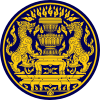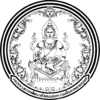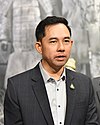List of government ministries of Thailand
This article includes a list of general references, but it lacks sufficient corresponding inline citations. (February 2016) |
The Government Ministries of Thailand (Template:Lang-th are the government agencies that compose the executive branch of the Government of Thailand. Each ministry is headed by a minister of state (Template:Lang-th, RTGS: Ratthamontri Wa Kan Krasuang) and, depending on the prime minister, several deputy ministers (Template:Lang-th . The combined heads of these agencies form the Cabinet of Thailand. There are 19 ministries.[1] The combined employees of these departments make up the civil service of Thailand.
Ministries
 |
|---|
|
|
|
|
History
During the Rattanakosin Period, the kingdom's administration was similar to that of the Ayutthaya Period. There were two chief ministers (Template:Lang-th: the first running military affairs or samuhakalahom (Template:Lang-th, and the second Samuhanayok (Template:Lang-th for civilian affairs. The civilian ministry was divided further into four kroms (Template:Lang-th, headed by a senabodi (Template:Lang-th or 'minister'. This type of administration was called the Chatusadom (Template:Lang-th :
| Ministries | |||
|---|---|---|---|
| Name | Thai Name | Head | Purpose |
| Krom Nakhonban or Kromma Wiang | กรมนครบาล หรือ กรมเวียง | Senabodi | Cities and local administration |
| Kromma Wang | กรมวัง | Senabodi | Palace affairs |
| Kromma Khlang | กรมคลัง | Senabodi | Treasury and trade |
| Kromma Na | กรมนา | Senabodi | Agriculture and land |
Rama V reforms
King Chulalongkorn (Rama V), who had received a European education and traveled widely, reformed the administration of the state. In 1875, he issued a royal decree to bring about this reform, dividing and creating many departments, and thereby preventing the archaic system from collapsing.
The administrative reforms of Chulalongkorn created six ministries (Template:Lang-th, each headed by a minister of state or (Template:Lang-th, RTGS: ratthamontri):
| Ministries | ||||
|---|---|---|---|---|
| Name | Thai Name | RTGS | Head | Purpose |
| Ministry of Interior | กระทรวงมหาดไทย | Krasuang Mahatthai | Minister | Local administration and the north |
| Ministry of War | กระทรวงยุทธนาการ | Krasuang Yuttana Thikarn | Military and the south | |
| Ministry of Metropolitan | กระทรวงนครบาล | Krasuang Nakhonban | Bangkok and surrounding area | |
| Ministry of the Royal Household | กระทรวงวัง | Krasuang Wang | Palace affairs | |
| Ministry of Finance | กระทรวงการคลัง | Krasuang Kan Khlang | Finance and commerce | |
| Ministry of Agriculture | กระทรวงเกษตราธิการ | Krasuang Kasettrathikarn | Agriculture and land | |
A further four were soon added:
| Ministries | |||
|---|---|---|---|
| Name | Thai Name | Head | Purpose |
| Ministry of Foreign Affairs | กระทรวงการต่างประเทศ | Minister | Foreign affairs and relations |
| Ministry of Justice | กระทรวงยุติธรรม | Minister | Justice and the judiciary |
| Ministry of Transport and Communication | กระทรวงโยธาธิการ | Minister | Transport and communication (railways and telegrams) |
| Ministry of Education | กระทรวงธรรมการ | Minister | Education |
By 1900 the entire structure was formed. The ten ministries became the center of Siamese government and rule. After the 1932 Revolution, most of the ministries were retained by the Khana Ratsadon, however from then on the ministers were chosen by the prime minister and not the king.
See also
- Cabinet of Thailand
- Independent agencies of the Thai government
- Government of Thailand
- List of state enterprises of Thailand
- Politics of Thailand
- Prime Minister of Thailand
References
- ^ "Government Agencies". Office of the Prime Minister (OPM) (Thailand). Retrieved 5 July 2016.
- ^ ""Thai Government Agency"". Retrieved 19 March 2021.
External links
- Official webpage
- Reshaping Thailand through Bureaucratic Reform and Development
- The History of Thailand's Administration Website of the Department of Provincial Administration – DOPA (in English) ([1] Internet archive of 25 November 2009)

































